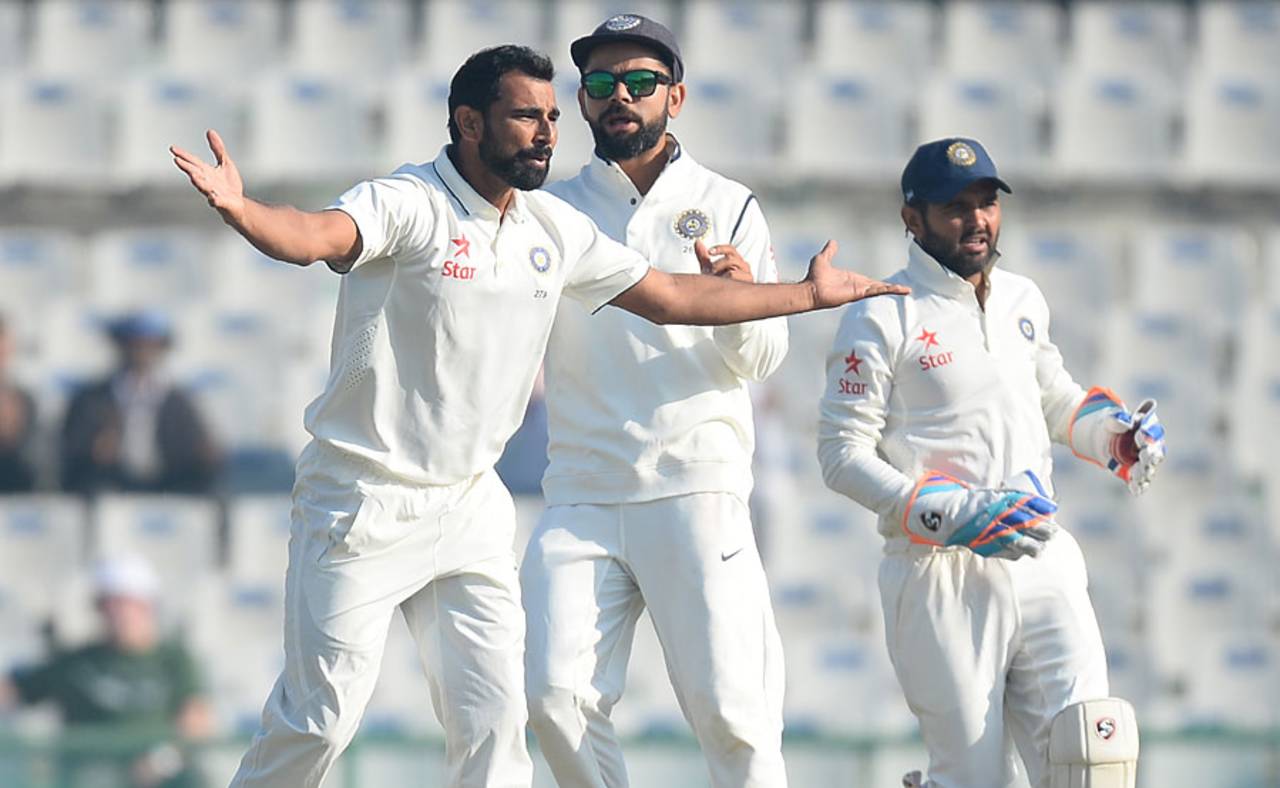Chopra: How not to handle a bowler
An analytical look at some of the technical highlights from the second day's play in Mohali
Aakash Chopra
27-Nov-2016

Mohammed Shami is India's second-highest wicket-taker in the series so far • AFP
Not just release bowlers anymore
In Indian conditions, we often see fast bowlers are used as release bowlers. Since the conditions are never conducive enough for faster bowlers to inflict serious damage, they are used in shorter spells to give spinners a break and also, to break the monotony. A wicket from their side is considered a bonus. But in this series, both Mohammed Shami and Umesh Yadav have not just bowled with pace but also penetration. The moment your pacers start contributing in these conditions, the team's reliance on spinners decreases manifold.
The ball takes a piece of the pitch with it
The first ball of the 11th over, from Adil Rashid to Parthiv Patel, pitched on the good-length area, which forces you to come on to the front foot, right in front of the stumps. Upon landing the ball took some piece of the pitch with it. This is the first instance in this game when the ball has disturbed the surface and that could be seen as a sign of things to come. While you can get used to the rough outside off or leg stump, it becomes a little tough to handle if the area in front of the stumps starts wilting.
Moeen Ali and the defensive approach
In the next over, Moeen Ali operated without a fielder close to the bat. In case you wondered why England became so defensive so soon, the reason, apparently, is to wait for the ball to start reverse-swing. Alastair Cook has accepted that there is not enough help for spinners while the ball is new and the best chances of taking a wicket lay with seamers and therefore it is prudent to avoid leaking boundaries.
Which day, which pitch
The pitch on the first day wore the look of a day two pitch, for some pieces were moving before the start of day's play. Incidentally, the pitch on the second day was also looking almost identical to the pitch on the first day. There has not been any significant wear and tear. The footmarks are not that prominent and the cracks have opened marginally. Also, it seems that none of the balls pitched on the pieces that were moving.
The outside-off tactic
In the post-lunch session, the English seamers adopted the outside-off line with a heavily guarded off-side (7-2) field. The execution of this plan depends on two factors - maintaining an eight/ninth-stump line throughout and also, bowling a length that is neither drivable nor cuttable, and that's what the English seamers did relentlessly. The ways to counter this plan is to either walk across and reach out to the balls or have the patience to let everything go to the keeper. Both Cheteshwar Pujara and Virat Kohli chose the second option and showed the patience to execute it well in that session.
The other outside-off tactic
In the second innings of the second Test, Kohli got out to Rashid while driving a full ball that was fairly wide of outside off. It is not surprising that Rashid tried the same tactic a few times here too. There has not been as much turn and bounce in Mohali and Kohli has also played the shot with more control. But it is visible that every form of dismissal leads to further probing in Test cricket.

A beehive of Adil Rashid to Virat Kohli in the first innings•ESPNcricinfo Ltd
How not to handle a bowler
Gareth Batty's first over was the 47th over of the innings and that too close to the tea break. He leaked 22 runs in the three-over spell and then was reduced to being a spectator for a long time. His next spell comprised only 12 balls and, once again, close to the time when the second new ball was available. It's a fine example of how one must not handle a bowler.
Aakash Chopra is the author of three books, the latest of which is The Insider: Decoding the craft of cricket. @cricketaakash